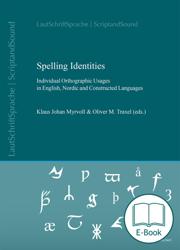This volume contains a selection of papers given at the 2nd Symposium on Linguistic Identities: Spelling, Writing and Identity, held on 29 and 30 November 2021 at the University of Stavanger, Norway. It also features two specifically commissioned contributions. The articles show how identity is expressed by linguistic means with particular regard to orthographic conventions. The focus is on English, Icelandic and Norwegian as well as constructed languages, and the time periods range from the early Middle Ages up to the present day. Some aspects covered include the spelling of names, the use of archaisms and the role of the intended audience.
This book, which is based on a symposium held at the University of Stavanger in November 2021, explores how orthographic conventions reflect identity across certain languages and historical periods, from the early Middle Ages up to the present day. It contains ten contributions, which are divided into three sections, covering English, Nordic languages (Icelandic and Norwegian), and constructed languages respectively.
The English section contains four articles ranging from eighth-century runic inscriptions on the Ruthwell Cross to fifteenth-century manuscripts that showcase distinctive regional spellings. These studies reveal how unique orthographic choices reflect the linguistic identities of communities and individuals, particularly in terms of geography and social factors. A final English-focused study examines the evolution of name spellings over centuries, tying orthographic changes to broader concepts of identity.
The five studies in the Nordic section cover Icelandic and Norwegian language history, with attention to onomastics and orthographic conventions as markers of cultural identity. Medieval Icelandic and Norwegian manuscripts reveal two separate writing traditions, despite minimal linguistic differences between the regions. The papers in this section also highlight Icelandic Enlightenment efforts to modernize spelling while retaining medieval elements, contrasting this with Norwegian naming trends in the nineteenth century, when names were increasingly adapted to align with national identity. The section closes by examining Norwegians' attachment to placename spellings, reflecting cultural and personal identity ties to family heritage and linguistic history.
There is one article in the final section that delves into constructed languages in fiction, particularly Klingon, Elvish, and imagined forms of English. It discusses orthographic representations in these languages in the Latin script, helping an English-speaking audience understand how the creators intended them to sound and function as unique linguistic identities within fictional contexts.
Through its detailed historical and cultural analyses, the book highlights how spelling choices serve as expressions of identity across diverse languages and periods. This work contributes to the fields of historical linguistics, orthography and sociolinguistics, with a primary audience of linguists, language historians, and scholars of cultural studies interested in the intersections of language, identity, and orthography.
Oliver M. Traxel is Professor of English Language and Linguistics at the University of Stavanger. He has a PhD in Anglo-Saxon, Norse, and Celtic from the University of Cambridge and habilitated in English Philology at the University of Münster. Before taking up the professorship in Norway he worked at various German universities, i.e. Darmstadt, Göttingen, Heidelberg, Munich, Münster, Saarbrücken and Würzburg. His main interests lie in English language history, medievalism and modern linguistics, and he has published widely on the representation of past language stages in the modern world. In 2023 he initiated the interdisciplinary MARRI project at Stavanger, which focuses on The Middle Ages in the 20th and 21st Centuries: Relevance, Reimagination, Inspiration.
Klaus Johan Myrvoll
is Professor of Nordic Linguistics at the Department of Cultural Studies and Languages, University of Stavanger. He received his PhD degree in Old Norse Philology from the University of Oslo in 2015 for a thesis on skaldic metre and the chronological development of skaldic verse. His main research focus is on skaldic poetry, particularly on the role of poetry in saga literature, and Nordic language history, both with regard to the ancient languages and the development of Modern Norwegian (“Nynorsk”). He has also published on other topics, such as manuscript transmission, name studies, genealogy and runology.
Die Reihe LautSchriftSprache ist der historischen Graphematik gewidmet. Als ein multidisziplinäres Forschungsgebiet stellt die Graphematik die Brücke zwischen Philologie, Sprachgeschichte, Epigraphik und Semiotik dar. Daher beschreibt die historische Graphematik die allgemeinen Strukturen überlieferter Schreibsysteme. So beschäftigt sie sich beispielsweise mit Veränderungen im System und der Reaktion darauf durch die einzelnen Sprecher- bzw. Sprachgruppen, d.h. deren individuelle Lösungsmöglichkeiten im Rahmen dieser Strukturen. Die geographischen und die chronologischen Koordinaten reichen von den historischen Alphabeten Europas bis hin zu den chinesischen Logogrammen über die hieroglyphischen und logosyllabischen Schriftsysteme des Mittelmeeres und des Vorderen Orients.


 Preface
Preface